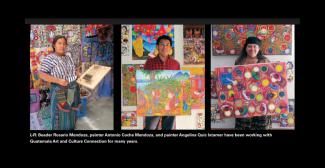
Guatemala Art and Culture Connection works with Maya villages around Lake Atitlan, Guatemala, and collaborates with traditional Maya communities in order to bring their art and crafts to the wider international market. The paintings and crafts depict themes that are an integral part of their life and culture and often incorporate designs and figures that are based on centuries-old traditions. “Our vision is to utilize this art and the crafts as a means of connecting people across borders and cultures and supporting local initiatives in the communities we work with. We also seek to increase awareness of the economic, political, environmental and social issues impacting these Indigenous communities and to cultivate an appreciation of their rich art and culture while helping to support the artists and local economy through the fair trade sales of their art and crafts,” say founders Imre and Lorna Kepes.
The villages that work with Guatemala Art and Culture Connection represent three Maya communities and languages: Tz’utujil, Kaqchikel, and K’iche. San Juan La Laguna (Tz’utujil) is smaller and more traditional and has the highest concentration of cooperatives. San Pedro La Laguna (Tz’utujil) is larger and is the birthplace of the art naïf style. Santiago Atitlan, the largest town on the lake with a population of 50,000, is known for the atrocities it has suffered during Guatemala’s civil war, including massacres of civilians, but today it is also known for the spectacular beadwork and weaving its artists create.
Guatemala Art and Culture Connection represents more than 30 artists and artisans. The artists are known for their distinctive style and their works have been exhibited in places such as the Smithsonian in Washington, D.C. and galleries and shows internationally. One of the artists, Angelina Quic Ixtamer, born in San Juan, explains, “Most of the women in my village do fine embroideries and weaving, but I wanted to do something different.” Quic also says she initially faced “severe criticism from other women because they regarded painting as exclusive to men.” As the first female oil painter from her village, Quic has become renowned nationally and internationally.
Quic, along with her husband, Antonio Coche Mendoza (also Tz’utujil and born in San Juan), opened their own gallery in 2002. She hopes to travel internationally to exhibit and sell her work. “What I love most about what I do is that when I paint, I think back to the lives of our predecessors and the work they did on the field, which is deeply rooted in my country’s culture. I used to help with the coffee harvest and picked about 60 pounds a day. Now my husband and I are able to support ourselves with our art,” she says. Coche is represented in UNESCO’s 2001 book, Art Naïf: Contemporary Guatemalan Paintings. His career as an artist began early and evolved rapidly. “I was the first person in my family to start painting,” he says, but has since taught several of his siblings how to paint. Today “many of the residents of San Juan appreciate how we are depicting and valuing our culture through our art. Painting the culture and the traditions helps to preserve them, and in addition helps to validate them.”
With the help of Guatemala Art and Culture Connection, artists like Quic and Coche have been able to bring their work to an international audience, fostering worldwide respect for Indigenous artists. The Kepes say that now, during these challenging times, “the artists and artisans we work with tell us that they are struggling to sell their art and support their families. We are exploring new ways to market their work and plan to open up an online store by the end of June.” A percentage of sales also goes to fund the local programs they support.
Please visit guatemalaartandcultureconnection.blogspot.com or the Facebook page, Guatemala Art and Culture Connection, for more information.
The 2020 Summer Bazaars in Newburyport and Tiverton in July are cancelled due to COVID-19. Please stay tuned for online shopping opportunities and future dates and locations at bazaar.cs.org.
